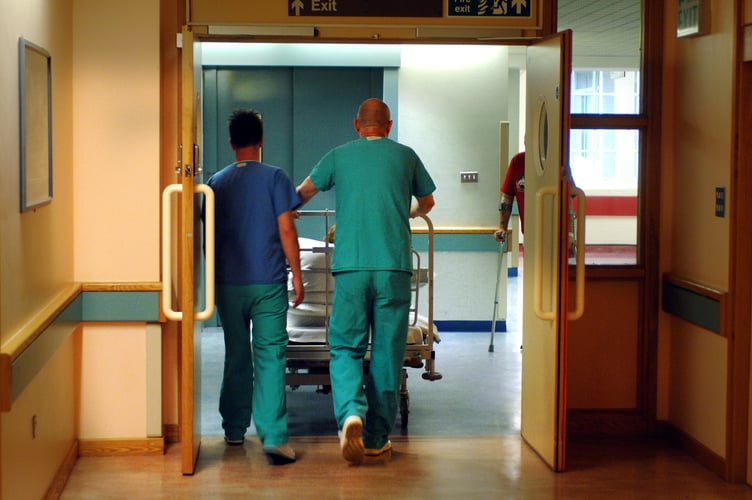Figures obtained by the Welsh Conservatives last week have revealed that in April,3,351 people who rang for an ambulance and were given an amber status had to wait over four hours for it to arrive.
According to monthly Welsh Government statistics, a staggering two-thirds (67.1 per cent or 10,157) of amber ambulances took over an hour to reach their patient.
The information uncovered that 344 people waited over 12 hours and that 14 waited over a day for an amber call to be reached.
Calls for ambulances are triaged into red, amber, and green calls. Red calls are life-threatening conditions like heart attacks, but serious conditions like strokes are classified as amber.
The figures also reveal that three red-calls took over an hour to reach their patients in April, two in Dyfed and one in the Swansea Bay health board area.
Only 51 per cent of responses to immediately life-threatening calls arrived within eight minutes, down from 61 per cent in April 2021.
The target of 65 per cent of red-calls reaching their patient within eight minutes has not been reached in over 18 months.
The news comes as it’s also revealed that more than a third of patients seeking the most serious A&E care at the Wye Valley Trust waited longer than four hours to be seen last month.
Welsh Conservative and Shadow Health Minister Russell George MS has branded ambulance wait times as “scandalous” following news of dozens of incidents when police cars had to be deployed as ambulances.
The MS said: “It is scandalous how long people have to wait for ambulance in Wales, no matter how serious the emergency – if you’re in need of one, your problem needs urgent attention.
“I cannot imagine the anguish people feel as they or a loved one are left languishing in pain because Labour’s mismanagement of the NHS has turned ambulance provision into a postcode lottery.
“We know that ambulance delays are down to them getting stuck at A&E departments, full and slow-moving because of issues in accessing other parts of the NHS.
“That’s why Labour need a plan to ensure people come to hospital as a last resort, not because they have no confidence in or access to other parts of the health service.”
Andrew RT Davies MS, the Welsh Conservative leader who submitted the question, added: “These waits are very concerning, more so because we had to dig them up because ministers do not routinely publish them.
“We know the pandemic has hit all aspects of the NHS hard, but we know that the NHS under Labour has been in dire straits for a long time and ambulance waits have been going downhill for a while.
“As I told the First Minister back in March, he has failed to plan for the end of Army assistance in the ambulance service and now patients and paramedics are paying the price.”

More than a third of patients seeking most serious A&E care at Wye Valley Trust wait too long
More than a third of patients seeking the most serious A&E care at the Wye Valley Trust waited longer than four hours to be seen last month, figures show.
The Nuffield Trust health think tank said delays to care are “uncomfortable at best and dangerous at worst” and cautioned that the coronavirus pandemic is not solely to blame for current pressures on A&E services across the country.
NHS guidance states that 95 per cent of patients attending accident and emergency departments should be admitted, transferred or discharged within four hours.
But Wye Valley NHS Trust fell well behind that target in May, when just 63 per cent of the 6,023 attendances at type 1 A&E departments were seen within four hours, according to figures from NHS Digital.
Type 1 departments are those which provide major emergency services – with full resuscitation equipment and 24-hour consultant-led care – and account for the majority of attendances nationally.
It means 37 per cent of patients seeking the most urgent care at the Wye Valley Trust waited too long to be seen last month, compared to 40 per cent in April, and 27 per cent in May 2021.
The King’s Fund think tank warned patients are waiting longer in A&E departments for a “wide range” of reasons, including rising A&E attendances and emergency admissions to hospital, fewer hospital beds being available and staffing strains.
“The four-hour A&E waiting time standard is one of the most high-profile indicators of how the NHS is performing,” it said in a recent report.
“The sustained declines in performance against this waiting time standard place a significant toll on patients and staff alike and are a clear indication of the pressures the wider health and care system is under.”
The 95 per cent standard has not been met across the NHS in England since July 2015 – and last month, just 73 per cent of A&E attendances were admitted transferred or discharged within four hours, compared to 84 per cent in May 2021 and 87 per cent in May 2019.
Performance was worse in type 1 departments, where just 60 per cent of patients were seen on time in May, down significantly from 76 per cent during the same month last year, and 79 per cent before the coronavirus pandemic.
Nuffield Trust fellow Jessica Morris said: “Performance against the four-hour target has deteriorated rapidly during the pandemic but looking back further it is clear that waiting times for patients in major emergency departments have been growing for the last decade.
“A decade ago, one in 20 people found themselves waiting longer than four hours to be either admitted, transferred, or discharged from major A&E but the most recent figures show this has jumped to four in 10 people. These waits are uncomfortable for patients at best and dangerous at worst.”
She added that a lack of resources and staffing pressures are fuelling waiting times across the entire health service.




-with-MS-for-Mid-West-Wales-Cefn-Campbell.jpeg?width=209&height=140&crop=209:145,smart&quality=75)
Comments
This article has no comments yet. Be the first to leave a comment.